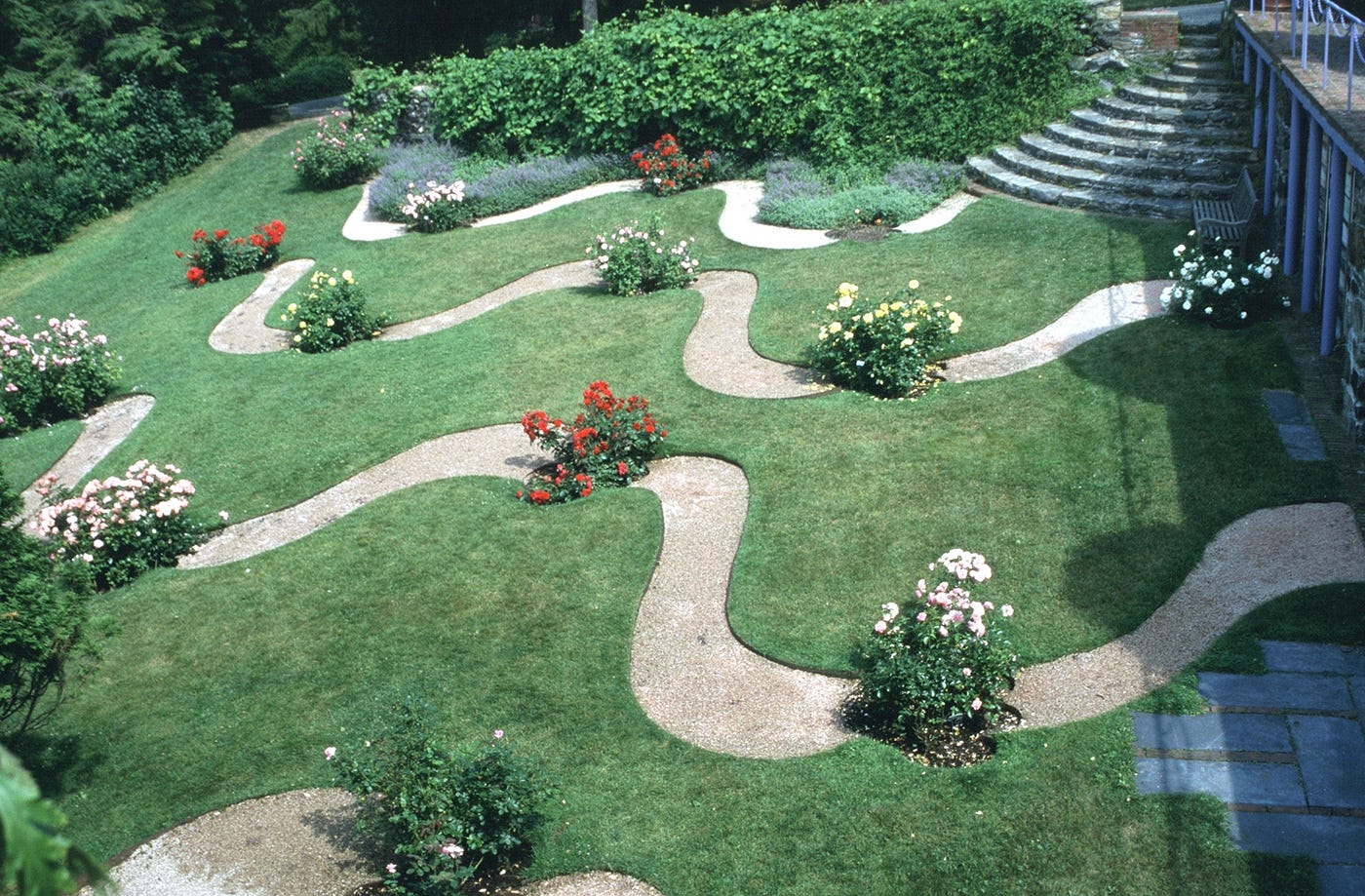Curves: Sinuous Lines of Grace
Have you ever walked through a garden and felt a wave of peace wash over you? That sensation is partially a response to the shapes and lines within the overall space. Curved lines give an unhurried quality to any setting.

The beguiling nature of a gentle arc prompted the 18th-century English landscape designer Capability Brown to refer to curves in the landscape as the “sinuous line of Grace.” They reflect the forms we see in nature: rounded flower petals, pinecones, leaves and seashells.
Walks, plant beds and walls can all be shaped as a curved element. An undulating walk appears like a meandering stream, a rounded plant bed embraces a lawn and curving walls of any kind make a bold statement.
A wonderful example of this is the unique rose garden designed by Fletcher Steele in the early 20th century at the historic estate, Naumkeag, in Stockbridge, Massachusetts. It is a series of parallel curving gravel paths punctuated by rosebushes. Its flowing lines imply moving water, and as you look down upon the garden from the balcony, the fluidity illustrates how curves in the landscape can create “music for the eye”.
Four Examples
The curved outdoor staircase, the Blue Steps, at Naumkeag in Stockbridge, Massachusetts, illustrates the appeal of rounded lines beautifully. It also shows how color can be used in inventive ways. The airy, curved white railings in front of deep green curved yew hedges contrast with the white birches. Water flows down the hill and shoots out in the blue alcoves. Sublime.

The allure of winding paths was acclaimed by American landscape design, Andrew Jackson Downing. In 1849, in his “A Treatise on the Theory and Practice of Landscape Gardening, Adapted to North America”, Downing advocated that, “trees should stand in irregular groups not in straight rows, and paths and borders should be winding or serpentine, adapting to the natural inequalities of the surface.”
The 19th century author, Edith Wharton, followed this advice and laid out the walks in her estate, The Mount, in a sinuous arrangement.

An extraordinary example of a bold serpentine curve outdoors is the rustic fieldstone wall at the Storm King Art Center in Mountainville, New York. Created by Scottish artist Andy Goldsworthy and a crew of British stonemasons, the 2,278 feet long wall was built with native stones gathered from the surrounding woods. The first section of the wall weaves in and out of trees and ends in a sunken pond. It then emerges out from the other side of the pond and leads back uphill. People walk alongside the curving wall as it winds through field and forest.

Ancient Chinese garden designers used curving perimeter walls to enclose their revered gardens. Osvald Siren described the winding grace of a Chinese garden wall in his book, Gardens of China, saying, “They seldom follow straight lines, and as a rule are not broken in sharp angles; they rather sweep in wide curves, ascending and descending according to the formation of the ground and thus often have the appearance of being elastic or modeled rather than built up.” The elasticity of a curve lends a mysterious air to any garden.

The Elasticity of a Curving Walk
You can make a simple linkage more interesting by laying out a walkway in a strong, playful line. This is not a direct walk that leads to a front door but rather a fun garden path. In the photo below, I laid out an S-shaped paver walk to add a lyrical quality to the scene.
There are many ways to lay out a curve in a garden. A common way is to lay a garden hose on the ground to make a free-form curve. This is not my preferred way because it creates a wriggly shape which is not very graceful. Curves should have a defined radius. Using the metaphor of music - a rhythmic flow of line and form is enchanting.
A more ordered approach is to determine the radius of the arc that you would like to create. Then, using a 100-foot tape measure as your compass, mark out a uniformly shaped curve from a central radius point. You can mark the curve on the ground using chalk, marking paint or a line of powdered limestone, as you pivot around. Such a gentle curve creates a more even “disposition” to the scene.

Another example from one of my landscapes is this mossy serpentine line in the woods. A bench is nearby. This path leads the eye of the person sitting there through a shady area.

I will write more about curves in future posts but I hope this piques your interest! Let me know - I would love to hear feedback.




Loved these different pathways ..... am going to look at changing one of mine to a curved version!
Beautifully written. These are some of my favourite landscapes. I appreciate your thoughts re the strength and lyric quality of organic lines and the importance of understanding their geometry. It is certainly no less disciplined than formal rectilinear design.